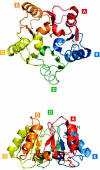Eukaryotic initiation factor 6 mediates a continuum between 60S ribosome biogenesis and translation
- PMID: 19373251
- PMCID: PMC2680881
- DOI: 10.1038/embor.2009.70
Eukaryotic initiation factor 6 mediates a continuum between 60S ribosome biogenesis and translation
Abstract
Eukaryotic ribosome biogenesis and translation are linked processes that limit the rate of cell growth. Although ribosome biogenesis and translation are mainly controlled by distinct factors, eukaryotic initiation factor 6 (eIF6) has been found to regulate both processes. eIF6 is a necessary protein with a unique anti-association activity, which prevents the interaction of 40S ribosomal subunits with 60S subunits through its binding to 60S ribosomes. In the nucleolus, eIF6 is a component of the pre-ribosomal particles and is required for the biogenesis of 60S subunits, whereas in the cytoplasm it mediates translation downstream from growth factors. The translational activity of eIF6 could be due to its anti-association properties, which are regulated by post-translational modifications; whether this anti-association activity is required for the biogenesis and nuclear export of ribosomes is unknown. eIF6 is necessary for tissue-specific growth and oncogene-driven transformation, and could be a new rate-limiting step for the initiation of translation.
Figures







References
-
- Biffo S, Sanvito F, Costa S, Preve L, Pignatelli R, Spinardi L, Marchisio PC (1997) Isolation of a novel beta4 integrin-binding protein (p27(BBP)) highly expressed in epithelial cells. J Biol Chem 272: 30314–30321 - PubMed
Publication types
MeSH terms
Substances
Grants and funding
LinkOut - more resources
Full Text Sources
Other Literature Sources

